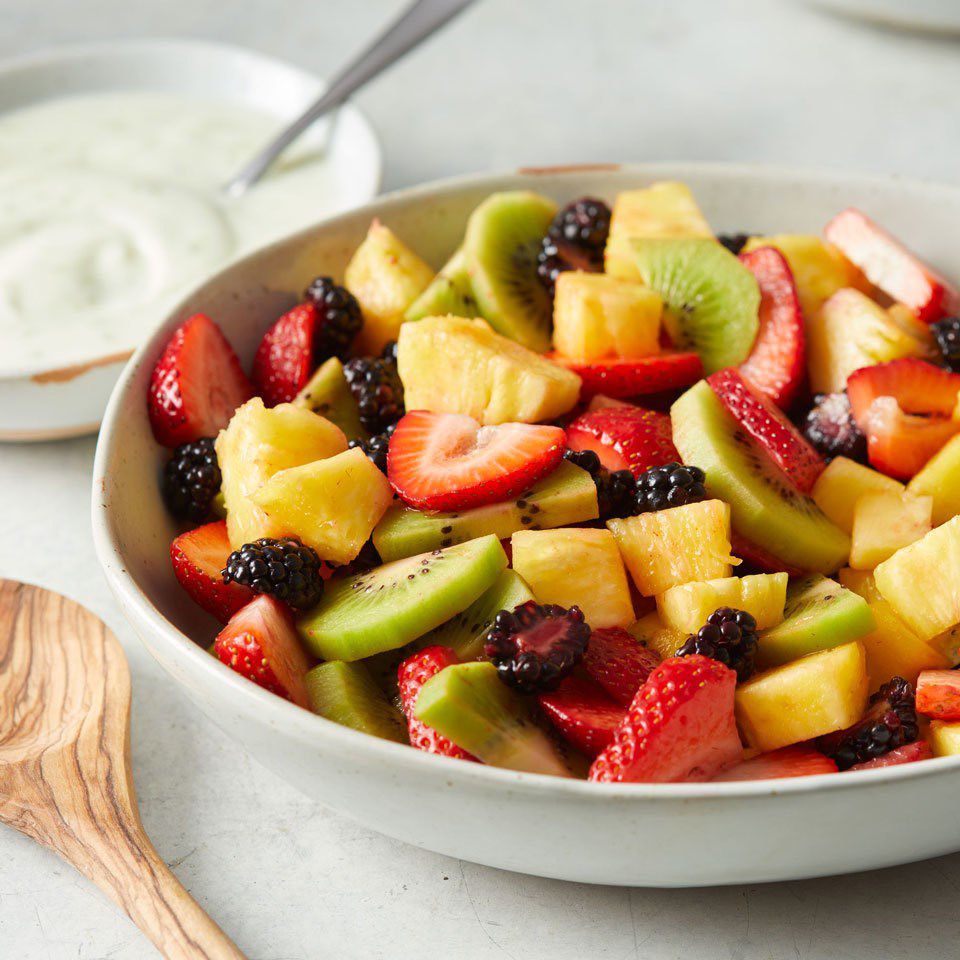The Best and Worst Fruits to Eat If You Have Diabetes

Good news for fruit lovers everywhere: eating fresh fruit is associated with a lower risk of diabetes and a lower risk of complications if you already have the disease, according to a recent study published in PLOS Medicine.
If you’ve been steering clear of fruit (like the Fresh Fruit Salad, pictured above) because of the sugar content, there’s no reason to do so, according to this study.
Researchers examined the dietary habits and health effects of over 500,000 Chinese people over a period of seven years. Even for those with diabetes, the researchers discovered that eating more fruit was not linked to increasing blood sugar levels. In fact, adults who ate fruit more often were less likely to become diabetics.
We consulted with a few qualified dietitians and certified diabetes educators to get their advice on the best and worst fruits, serving sizes, and the recommended daily intake of carbohydrates from fruit, as the study only examined consumption of fresh fruit and did not examine dried fruit or fruit juice.
It’s crucial to remember that “diabetes care is individualized,” according to Bowling Green State University nutrition professor Staci Freeworth, R.D., C.D.E. For this reason, it’s critical that diabetics consult a qualified diabetes educator. These experts can break down the recommended daily intake of carbohydrates based on your own circumstances and medical background.
Best Fruits to Eat
Dietitians agree on one thing when it comes to the finest fruits to eat, regardless of your diabetes status.
According to Daphne Olivier, R.D., C.D.E., founder of My Food Coach, “the best fruits for everyone to eat are the ones that create the least influence on blood sugar, often termed ‘low glycemic load,’ even if you do not have diabetes.” These consist of kiwi, dark cherries, raspberries, blueberries, blackberries, and other fruits with intense, deep hues. Antioxidants, which we know serve to neutralize free radicals, are responsible for the rich hue, but they also have other advantages that are beyond our comprehension.
In agreement, Amber Gourley, M.S., R.D. of the Disobedient Dietitian says, “I usually advise my clients to choose fruits with deeper hues.” Research indicates that Americans do not consume enough dark purple and red fruits, despite the fact that these fruits are among the best providers of antioxidants that reduce inflammation.
Eat More of These Fruits:
- Blueberries
- Blackberries
- Raspberries
- Dark cherries
- Kiwi
Worst Fruits to Eat
Just remember that no fruit is “the worst.” Any fruit can be included in a balanced diet and provides nutrients and fiber. On the other hand, because they contain more sugar than berries, bananas, pineapples, and mangoes are not given the best reputation.
Don’t completely shun them, though. The emphasis should instead be on reducing the rate at which your blood sugar rises. For instance, eating a banana by itself will cause your blood sugar to rise quite quickly. “However, you will lessen the impact of the fruit on your blood sugar if you combine it with foods that contain healthy fats, like blueberries and walnuts or apricots and mozzarella cheese,” explains Olivier. “By slowing down the absorption of fruit’s glucose, these fats help to lower blood sugar spikes.” Because of their high protein and fat content, nuts and nut butters, plain yogurt, cheese, and even avocados can all help reduce the blood sugar reaction that occurs when you consume fruit.
The same logic behind the suggestion you’ve heard to eat the entire fruit rather than sip fruit juice. According to Gourley, the fiber in the entire apple is lost in the juice. Fiber aids in reducing how quickly sugar is absorbed. “Drinking fruit juice also makes it easy to consume far more carbohydrates than necessary,” the expert adds.
The same goes for dried fruit: “Dried fruit is a great snack, but 1/4 cup has 15 grams of carbohydrates, so I suggest using dried fruit on salads or mixed into plain yogurt instead of eating it alone,” Gourley says.
How Much Fruit Is Too Much?
According to the U.S. Dietary Guidelines, adults, both male and female, should eat two cups of fruit on average per day. One piece of fruit, such as an apple or peach, or one cup of chopped fruit would constitute a one-cup portion.
“Generally speaking, consuming a handful-sized portion of fruit three times a day is suitable,” states Olivier. Just don’t forget to eat it with fat or protein. “An apple alone can increase blood sugar levels more quickly than an apple combined with almond butter for a snack.”






